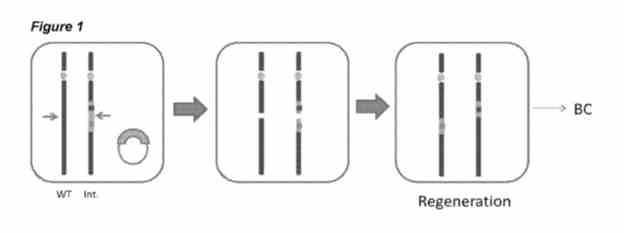Targeted translocation
Translocation between 2 homologous/homeologous chromosomes via double-strand break and rejoining
KeyGene reference: P147
Invention
 The method of the invention results in targeted translocation between two homologous or homeologous chromosomes in a plant cell via the introduction of a double-strand break in each of the two chromosomes using a site-specific nuclease, such as a ZFN, a mechanuclease, a TAL effector nuclease or a CRISPR system nuclease, and subsequently rejoining exchanged chromosome arms.
The method of the invention results in targeted translocation between two homologous or homeologous chromosomes in a plant cell via the introduction of a double-strand break in each of the two chromosomes using a site-specific nuclease, such as a ZFN, a mechanuclease, a TAL effector nuclease or a CRISPR system nuclease, and subsequently rejoining exchanged chromosome arms.
Benefit
Targeted translocation of chromosome arms is highly beneficial in breeding by speeding up the production of desired phenotypes without introducing foreign DNA. More in particular, targeted translocation enables to break linkage drag, tailor introgression, generate gene fusions, induce intragenic recombination and manipulate polyploid genomes. In addition, the present method can be applied in the process of fine mapping.
Vision
By steering towards the introduction of desired-, while removing undesired- loci without introducing foreign DNA, targeted translocation is an advantageous tool in the kit for plant breeding. The option to use CRISPR-system nucleases makes sure the method of the invention is highly agile and easily applicable.
Patent
Click on the link for an overview of the patent family in the European Patent Register: WO2014/104878
Please note that the European Patent Register may not be extensive and/or accurate, for which KeyGene is not responsible. Please contact your patent expert for further information.
Contact us
Would you like to explore the possibilities for obtaining a license for this technology? You can contact our licensing team by mail.
Would you like to know more about our technologies and licensing possibilities? Visit our webpage about Licensing KeyGene’s proprietary technologies.